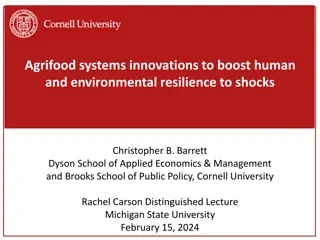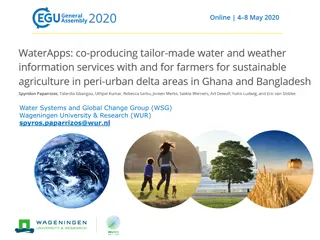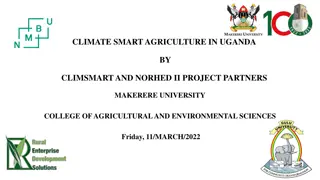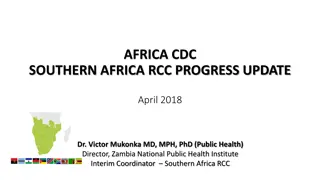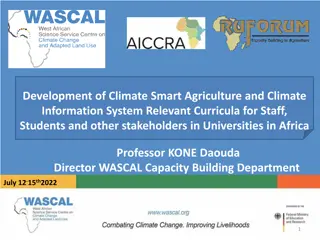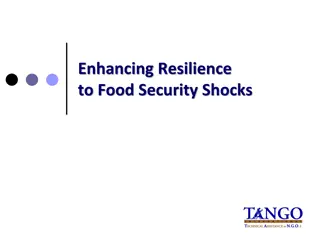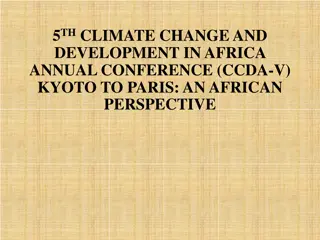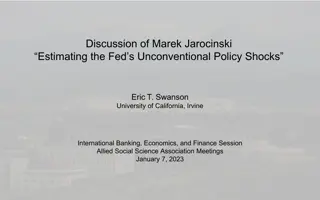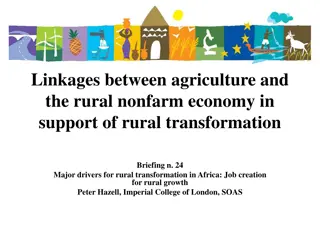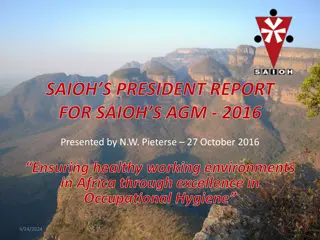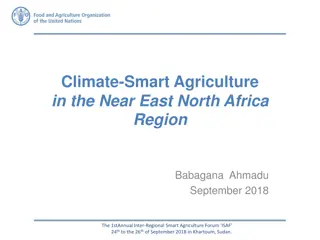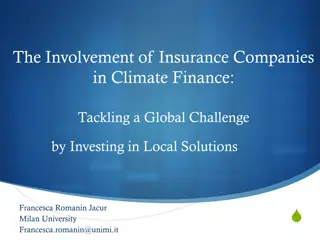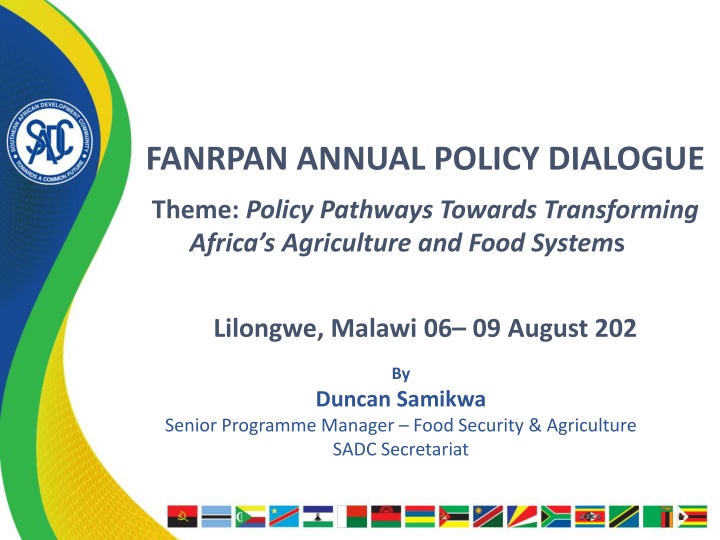
Addressing Climate-Related Shocks in Southern Africa Agriculture
The impact of climate-related shocks on agricultural productivity and food availability in Southern Africa, explored through droughts, floods, storms, and their economic implications. The region's vulnerability to extreme weather conditions and the need for robust policy pathways to ensure food security and nutrition.
Download Presentation

Please find below an Image/Link to download the presentation.
The content on the website is provided AS IS for your information and personal use only. It may not be sold, licensed, or shared on other websites without obtaining consent from the author. If you encounter any issues during the download, it is possible that the publisher has removed the file from their server.
You are allowed to download the files provided on this website for personal or commercial use, subject to the condition that they are used lawfully. All files are the property of their respective owners.
The content on the website is provided AS IS for your information and personal use only. It may not be sold, licensed, or shared on other websites without obtaining consent from the author.
E N D
Presentation Transcript
FANRPAN ANNUAL POLICY DIALOGUE Theme: Policy Pathways Towards Transforming Africa s Agriculture and Food Systems Lilongwe, Malawi 06 09 August 202 By Duncan Samikwa Senior Programme Manager Food Security & Agriculture SADC Secretariat
Outline The impact of climate-related shocks on agricultural productivity and food availability. Economic shocks and their effects on food prices and access. Health crises, including pandemics, and their implications for nutrition security. The SADC Vulnerability Assessment Analysis Programme and how it works with countries to better address vulnerabilities Recommendations
1. The impact of climate-related shocks on agricultural productivity and food availability. According to The Africa Report on Disaster Risk Reduction (DRR) 2015-2018 droughts, floods, storms, and epidemics cause the most loss of lives, livelihoods, critical infrastructure, and have the most significant impact on countries' economies. The Southern African Development Community (SADC) Regional Resilience Framework 2020-2030 also shows that the primary climate hazards experienced in the region are drought, floods, and tropical cyclones. These hazards together with epidemics have direct or indirect impacts on the agriculture sector with consequences for Food Security and Nutrition. Agriculture is central to the economic growth and development of the SADC region as it accounts for 70 per cent of the regional Gross Domestic Product (GDP) through production, food systems processing and trade flows.
1. The impact of climate-related shocks on agricultural productivity and food availability../2 Southern Africa has been chosen as a climate hotspot by the Intergovernmental Panel on Climate Change (IPCC). The region is prone to recurrent extreme climatic shocks and has experienced normal rainfall in only one of the last five cropping seasons since 2016/17. The most pronounced manifestations of climate change and variability in the region include: (i)An increase in temperature, leading to heat stress and reduced crop yields. (ii)Changes in rainfall patterns erratic rainfall (iii)Delayed onset of the rainfall season and an early tailing off, thus reducing the growing period for crops and yields; (iv)Human health, which is already compromised by a range of factors such as elevated levels of disease outbreaks such as malaria and cholera which are compounded further by the impacts of climate change and climate variability; and (v)Crop and livestock diseases and pests can drastically decrease or destroy harvest and vegetation critical for a healthy ecosystem that is of environmental service to many vulnerable communities.
1. The impact of climate-related shocks on agricultural productivity and food availability../3
1. The impact of DROUGHT on agricultural productivity and food availability../3 Primary impacts Secondary impacts Social Migration, resettlement, conflicts between water users 1 Disrupted water resources 2 Increased quest for water Increased conflicts between water users 3 Marginal lands become unsustainable Poverty, unemployment Overstocking and therefore reduced quality of livestock 4 Reduced grazing quality, and crop yields 6. Increased food insecurity Malnutrition, and famine; civil strife, and conflict 7. Increased urbanization Social pressure, reduced safety Environmental Increased damage to natural habitats 8. Loss of biodiversity Reduced forest,crop, Increased daytime temperature Increased evapotranspiration rangeland Reduced income and food shortages Increased fire hazard Crop withering, and dying 9. 10. 11. and Desertification, and erosion 12. Decreased soil productivity soil degradation 13. Decreased water resources Lack of water for feeding and drinking More waterborne diseases, lower accessibility to water 14. Reduced water quality Economic 15. Reduced business with retailers Increased prices for food and arming commodities Drastic price increases; expensive imports/substitutes 16. Food and energy shortages The increased expense of buying food, loss of income 17. Loss of crops for food and income 18. Reduction of livestock quality Sale of livestock at reduced market price 19. Water scarcity Increased transport costs Deepening poverty; increased unemployment Increased debt; increased credit risk for financial institutions 20. Loss of jobs, income, and property 22. Less income from tourism and recreation Increased capital shortfall
1. The impact of FLOODS on agricultural productivity and food availability../3 Primary impacts Secondaryimpacts Social 1. 2. 3. 4. 5. Disruption of water resources Employment lay-offs Increased food insecurity Increased pollutant concentrations Increased urbanization Migration, resettlement, conflicts between water users Reduced or no income Malnutrition, and famine; civil strife, and conflict Public health risks Social pressure, reduced safety Environmental Increased damage to natural habitats 6. Loss of biodiversity 7. 8. 9. Reduced forest, crop, and rangeland productivity Decreased water resources Reduced water quality Reduced income and food shortages Lack of water for feeding and drinking More waterborne diseases Economic 10. Reduced business with retailers Increased prices for farming commodities 11. Food and energy shortages Drastic price increases; expensive imports/substitutes 12. 13. 14. 15. Loss of crops for food and income Reduction of livestock quality Water scarcity Loss of jobs, income, and property The increased expense of buying food, loss of income Sale of livestock at reduced market price Increased transport costs Deepening poverty; increased unemployment 16. Less income from tourism and recreation Increased capital shortfall 17. Forced financial loans Increased debt; increased credit risk for financial institutions
1. The impact of STORMS/CYCLONES on agricultural productivity and food availability../3 Southern Africa on average faces 12 tropical cyclones form in the Southwest Indian Ocean Basin every year, of which about 25% make landfall between November and May. The various combinations of fierce winds and heavy rainfall (storm surges) make cyclones one of the most violent and destructive of all meteorological hazards. Storms have caused substantial damage to social, and economic infrastructure, and significant displacement of households, and loss of life (UNISDR, 2014). As a result of the cyclone activity during the peak period of November to May, storms can account for about 35% of damages, and losses in the region.
2. The Economic shocks and their effects on food prices and access. The latest data provided by member states in May 2024 and from the World Economic Outlook database of April 2024 indicate that in 2023 SADC member states were grappling with the economic impacts of extreme weather and the conflict in Ukraine as well as the lingering economic effects of the COVID-19pandemic. Globally synchronized monetary policy tightening and withdrawal of fiscal stimuli to curb rising inflation led to economic growth slowing down. The region recorded an average economic growth of 4.1 percent in 2023, a slight decline from 4.8 percent in 2022. Regional economic growth is forecasted at 4 percent in 2024, largely shaped by the global economic outlook, inflation developments, the evolution of geo-political tensions and the recurrence of climate disasters (IMF, April 2024). Intensified geoeconomic fragmentation could reduce portfolio and foreign direct investment flows, slow the pace of innovation and technology adoption, and constrain the flow of commodities across fragmented blocs, resulting in large output losses andcommodity price volatility (IMF, April 2024). Regional average inflation slowed down from 12.1 percent in 2022 to 10.2 percent in 2023 but is projected to accelerate to 26.8 percent in 2024 largely driven by the anticipated increase in commodity prices, in particular crude oil and food, and increased freight charges due to supply chain disruptions and exchange rate depreciation. The IMF reported that the fiscal position of many Sub-Saharan African countries has deteriorated over the past decade, exacerbated by repeated shocks, limited financing options and high borrowing costs. This funding squeeze partly reflects a reduction in traditional funding sources, particularly Official Development Assistance (ODA), a critical support for most countries
2. The Economic shocks and their effects on food prices and access /2 The Southern African region s current account deficit as a share of GDP slightly widened from an average of 3.9 percent in 2022 to 4.1 percent in 2023 largely due to low commodity prices, exchange rate depreciation (especially in member states that rely heavily on commodity exports) and significant imports related to mega projects in countries like Namibia, Mozambique and Tanzania. In 2024, the current account deficit is projected to narrow to 2.7 percent of GDP underpinned by anticipated improved export receipts driven by firming international commodity prices. Foreign reserves declined from an average of 4.4 months of import cover in 2022 to 4.2months in 2023 and are estimated to reduce further to four months in 2024. A significant increase in grain imports following the regional drought may worsen the current account deficit and result in a foreign reserves drawdown and weakening of local currencies (SSA-REO, April 2024). For the region s net food-importing countries, like Angola, Eswatini, Lesotho, Mozambique, Namibia and Zimbabwe, currency depreciation against the US dollar means higher food import bills are passed on to the consumer, resulting in elevated food inflation. The IMF highlighted that in 2023, most
3. Health crises, including pandemics, and their implications for nutrition security. The 2023 Joint Malnutrition Estimates report shows that there has been insufficient progress in reaching the 2025 World Health Assembly Global Nutrition targets and the SDG 2030 targets, both globally and in the region. Stunting prevalence (Children under 5 years with chronic malnutrition) in the SADC region In the region, all four countries that have declared national disasters due to El Nino have stunting prevalence above 20%. Madagascar, Malawi, and Zambia, have stunting prevalence of 39%, 34%, and 31% respectively considered very high according to the WHO classification Zimbabwe with a prevalence of 22% considered high. and
3. Health crises, including pandemics, and their implications for nutrition security /2 The current prevalence of wasting indicates that more than 4 million children in the SADC region require treatment services. Wasting reflects immediate deprivation, exacerbated by the climate crisis, disease, and socioeconomic conditions. Wasting (Children under 5 years with acute prevalence in the SADC Region malnutrition) which is currently Evidence indicates that wasting, especially episodes of severe and moderate wasting expose children to increased risk of mortality. A child with severe wasting has a risk of death up to 12 times higher than a child who is not malnourished, while a moderately wasted child faces 3 times the risk of death. Untreated severe wasting carries a case fatality rate of up to 21%. For those children who survive, repeated episodes of wasting increase the risk of chronic malnutrition. Hence, there is a need for immediate malnutrition management interventions. prevention and The recent El Ni o crisis, the worst to hit Southern Africa in the last 40 years, poses a greater risk for the countries that have declared El Ni o drought-induced crises and those that are at high risk of food insecurity. Early analysis indicates that the levels of malnutrition are expected to increase, reaching their peak in the first quarter of 2025,
3. Health crises, including pandemics, and their implications for nutrition security /3 Various assessments since the beginning of 2024 following the onset of the El Ni o crisis. Nutritional inadequacies detrimentally affect human capital outcomes including cognitive and developmental households likely to adopt negative coping mechanisms to survive, such as reducing the frequency of meals, choosing poor-quality and reduced quality foods, and using unsafe water sources for drinking. Minimum Acceptable Diet for SADC countries outcomes, with Recent analysis indicates that food poverty leads to inadequate and poor-quality diets, as well as diseases, which are the primary causes of chronic malnutrition. These issues are worsened by factors such as poor access to essential health services and other socio-economic issues. In the region, children continue to have inadequate Infant and Young Child Feeding (IYCF) practices. Most children do not receive a minimum acceptable diet, and the rate of exclusive breastfeeding is low, coupled with poor caregiving practices. According to the State of the World s Children (2023), the average minimum acceptable diet for the region is 14%, with individual countries ranging from 5% to 37%, as shown in the figure below Anaemia prevalence in women 15-49 years in SADC Countries
4. The SADC Vulnerability Assessment Analysis Programme and how it works with countries to better address vulnerabilities The trend of increased food and nutrition insecurity suggests that food insecurity is not simply a transitory phenomenon caused by short term, climatic shocks Understanding Food and nutrition insecurity and vulnerability It is deeper problem that goes beyond the impact of natural hazards to more structural underlying causes This necessitates a comprehensive assessment of the extent and depth of the vulnerability and analysing trends over time to inform the design and implementation of appropriate policies and programmes for emergency response and regular development.
4. The SADC Vulnerability Assessment Analysis Programme and how it works with countries to better address vulnerabilities 2 Food and nutrition insecurity and livelihood vulnerability compounded by recurrent shocks 2017/18 and 2023/24 Dry spells, erratic rainfall and cyclones (Madagascar Dry spells, erratic rainfall and cyclones (Madagascar) ) Summer crop production likely to be affected Crop and Livestock pests and diseases Crop and Livestock pests and diseases New/Emerging - Fall armyworm Tomato Leaf Miner and Highly Pathogenic Avian Influenza 2016/17 El Ni o El Ni o induced drought and floods induced drought and floods 2015/16 40 million people became food insecure and over 600,000 livestock died Dry spells and drought Dry spells and drought Adversely affected agricultural production 21014/5
Regional Vulnerability Assessment and Analysis ( (RVAA) ) Programme ../3 Mandate To strengthen national and regional vulnerability analysis systems in order to inform policy formulation, development programmes and emergency interventions that lead to a reduction in vulnerability The RVAA Programme comprises the National Vulnerability Assessment Committees (VACs) and the Regional Vulnerability Assessment Committee (RVAC). VACs are: Government led committees membership from a wide range of stakeholders in VAA including: government departments and agencies, civil society organisations, UN agencies, academia, local and international organisations. RVAC: SADC Secretariat led committee membership from a wide range of stakeholders in VAA including: VAC Chairpersons civil society organisations, UN agencies, ICPs international Programme funders (DFID & SDC)
Regional Vulnerability Assessment and Analysis ( (RVAA) ) Programme /3 Sustainable Development Goals (SDGs) Zero Hunger Challenge Sendai Framework for Disaster Risk Reduction 2015-2030 2014 Malabo Declaration - Comprehensive Africa Agriculture Development Programme (CAADP) 2015- 2025 SADC Food and Nutrition Security Strategy (2015-2025) SADC Regional Agricultural Policy SADC Regional Resilience Framework SADC Regional Indicative Strategy for Development (RISDP) 2015-2020 SADC s policy to promote sustainable and equitable economic growth and socio- economic development Aligned to global and regional development goals
Regional Vulnerability Assessment and Analysis ( (RVAA) ) Programme /4 Questions that Vulnerability Assessments and Analysis answer? Who are the food and nutrition insecure? Why are they food and nutrition insecure? Where are they? What is the extent of vulnerability? Recommendations on what could be done to alleviate the vulnerability othese questions are answered within a spatial (region, country, district, etc) and time (months, seasons etc) context
Regional Vulnerability Assessment and Analysis ( (RVAA) ) Programme /4 Analytical Frameworks/Methods Used Analytical Frameworks/Methods Used o Vulnerability Assessment Committees use a range of information collection and analysis tools to undertake vulnerability assessments including: Qualitative and quantitative methods such as household surveys, Key informant interviews, Focus groups, livelihoods analytical frameworks oSome of the secondary data used include Population stats, enumeration areas, Demographic Health Surveys, Integrated Household Surveys, Welfare surveys etc from National Statistics Offices, Meteorological information, Baseline livelihood data from NVACs, Crop production estimates from ministries of agriculture Reports from various development partners and NGOs in the countries.
Regional Vulnerability Assessment and Analysis ( (RVAA) ) Programme /5 Partnerships: Pursuing a common agenda Working with specialized agencies Working with specialized agencies African Risk Capacity (ARC), FAO, FEWS NET, Oxfam, UNICEF, UN OCHA & WFP Coordination Technical Working Groups Technical Working Groups Guide the introduction of emerging issues and innovations Centre of Excellence and Capacity Building Centre of Excellence and Capacity Building Integrated Phase Classification (IPC) Integrated Phase Classification (IPC) Information Management Information Management Nutrition, HIV Nutrition, HIV- -Aids, Gender Aids, Gender Market Assessments Market Assessments Urban assessment Urban assessment Resilience Resilience Achieving a shared understanding of food security and vulnerability
Regional Vulnerability Assessment and Analysis ( (RVAA) ) Programme /6 Utilization of VAA products 14 SADC Member States have functional VACs that respond to national information needs A wide range of stakeholders (governments, UN agencies, NGOs, researchers, media and academia) use VAA products Main information system in SADC region that provides an in-depth understanding of different dimensions of food security and vulnerability Provides Early Warning and monitoring services that are essential in mitigating and responding to shocks Informing key decision-making processes at national and regional levels (planning, budgeting and strategy and policy development and review) Informs response to emergencies and long-term development linked to Zero Hunger
Regional Vulnerability Assessment and Analysis ( (RVAA) ) Programme /7 Example of RVAA Product Food insecure population 2024/2025 (October 2024 - March 2025) Food insecure population % Change from 5yr avg (2019- 2023) 2024 Food insecure population as % of total population Food insecure population % Change from 2023/2024 Total National Population (SADC & MS presentations) Food insecure population 5yr avg (2019-2023) Food insecure population 2023/2024 Country Angola* 35 100 000 1 156 216 - 1 800 000 55.7% - 5.1% Botswana 2 446 000 36 515 57 909 58.6% 60.9% 2.4% 36 000 Comoros 870 000 - - - - - - DRC** 108 581 000 22 364 097 25 400 000 25400000 13.6% 0.0% 23.4% Eswatini 1 160 000 295 267 282 900 303 700 2.9% 7.4% 26.2% Lesotho*** 2 077 000 477 202 581 000 699 094 46.5% 20.3% 33.7% Madagascar 31 000 000 1 412 040 1 720 000 1 780 000 26.1% 3.5% 5.7% Malawi 20 270 568 2 723 983 4 400 000 5 700 000 109.3% 29.5% 28.1% Mauritius 1 262 000 - - - - - - 3 Mozambique 33 000 000 2 530 293 290 000 Namibia^ 3 022 401 509 701 695 000 1 434 790 181.5% 106.4% 47.5% Seychelles 99 000 - - - - - - 13 South Africa 62 283 000 12 851 026 16 300 000 26.8% 20.7% 26.2% 500 000 Tanzania 59 442 000 727 289 900 000 2 Zambia* 19 611 000 1 975 295 6 552 027 231.7% 221.5% 33.4% 038 000 Zimbabwe 15 179 000 4 726 363 4 249 000 7 627 138 61.4% 79.5% 50.2% SADC 395 402 969 51 554 043 57 091 900 67 654 658 31.2% 18.5% 17.1%
5 5. . RECOMMENDATIONS We recommend Mainstreaming of DRR in the agriculture, food security and nutrition sector to increase resilience of the sector. The proposed guidelines are summarized below: Priority 1: Understanding disaster risks in the Agriculture, Food Security and Nutrition Sector Identify and document all risks and hazards that impact the Agriculture, Food Security and Nutrition Sector; (i) Promote risk data and information management, including early warning to enhance the understanding of risks for the agriculture sector, for informed decision-making, both at the producer, government and other stakeholder levels associated with agriculture, food security and nutrition. Effect the use of data and information from the RVAA Programme and other regional sources or information; (ii) (iii) Promote regional and sub-regional platforms and networks to link the academic, scientific and technological community with policymakers and other relevant agriculture sector stakeholders to promote knowledge sharing on disaster risk, good practices and technologies among countries and institutions for resilience building and enhance livelihoods; and (iv) Promote resilience-building agro-based indigenous knowledge and local practices for early warning, conservation including local agro-biodiversity technologies and Climate Smart Agriculture (CSA) that addresses specific needs and interests of vulnerable groups including women farmers during disasters including climate- related impacts
5 5. . RECOMMENDATIONS Priority 2: Strengthen risk governance in the agriculture sector and FSN (i) Review sectoral policies and frameworks to ensure the adoption of the provisions of DRR through the disaster management cycle in the agriculture and FSN sector; (ii) Encourage collaboration between the agriculture, livestock, forestry, aquaculture and fisheries and strengthen technical and institutional capacities for planning, implementation, monitoring and evaluation to ensure the adoption of DRM and CCA provisions at all levels of the sector; (iii) enhance interagency collaboration to enhance synergies avoid duplications and foster the coherence of DRM actions between the agriculture, environment, and other relevant sectors to enhance the resilience of rural livelihoods and FSN; (iv) Set and promote minimum standards among regional, sub-regional and national institutions for addressing cross-border plant and animal health and food safety; and (i) Promote cross-border cooperation for policy and planning during the implementation of the shared ecosystem watersheds and marine-coastal resources, to increase resilience and reduce disaster risk in the agriculture sector.
5 5. . RECOMMENDATIONS Priority 3: Invest in disaster risk reduction for resilience in the agriculture sector and FSN (i) Promote harmonization and alignment between land use planning regulations, agriculture and food production standards that incorporate risk assessment; (ii) Strengthen public and private investments that promote environmentally friendly and sustainable resilient agricultural development that is climate and disaster risk- sensitive and competitive in the medium and long term; (iii) Promote sharing and harmonization of methodologies and practices for preparedness and response; (iv) Harmonize methods and tools for assessing damage and losses caused by disasters in the agricultural sector that takes into consideration the economic, social and environmental dimensions; (v) Strengthen the training of teaching of mothers and caretakers on acute and chronic malnutrition and encourage investments in nutrition enhancing programmes such as Immunisation, Vitamin A Supplementation (VAS) and Mass mid-Upper Arm Circumference (MUAC) screening in the Member States; (vi) Promote technical cooperation and sharing of best economic practices, including financial instruments for DRR focusing on among others the development of insurance schemes to reduce disaster risk and promote recovery; and (vii) Promote resource mobilization from funding mechanisms such as climate funds, and public-private partnerships and multi-country organisations for DRM and CCA of rural livelihoods.
5 5. . RECOMMENDATIONS Priority 4: Enhance better recovery, rehabilitation and reconstruction Link regional, sub-regional and national level early warning systems with agriculture sector institutions responsible for coordinating disaster risk assistance at the national level, to ensure delivery of accurate and user- targeted information on agricultural and FSN hazards for timely decision- making by producers, governments and other relevant stakeholders; (i) Facilitate the development of mechanisms, contingency plans and for an effective and timely response by the agriculture sector including for cross- border hazards; (ii) (iii) Promote regional collaboration for the timely delivery of disaster response, rehabilitation, recovery and reconstruction needs for the agriculture, food security and nutrition sector, which includes considerations for the development of food and financial reserves and other mechanisms for the restoration of ecosystems functionality; and (iv) Enhance capacities and sharing of good practices for livelihood rehabilitation, recovery and reconstruction that promotes building back better approaches.
THANK YOU MERCI OBRIGADO www.sadc.int Facebook: https://www.facebook.com/sadc.int/ Twitter : https://twitter.com/SADC_News Email: prinfo@sadc.int

